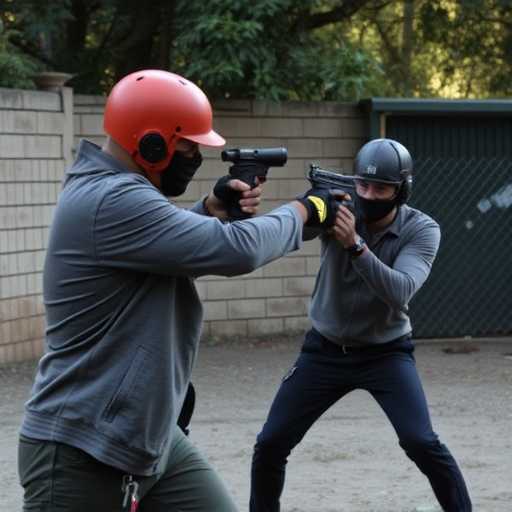Stun guns (electronic control devices) use high-voltage, low-current electrical pulses through pronged electrodes to temporarily paralyze and incapacitate attackers. Legal status varies widely across US states, impacting personal and law enforcement usage due to differing opinions on public safety and nervous system effects. Stun guns can cause intense pain, muscle contractions, disorientation, nausea, and respiratory distress, with potential long-term health risks for individuals with neurological conditions or heart problems. Understanding state regulations and training are crucial for safe stun gun ownership and responsible use, emphasizing employment as a last resort and awareness of potential consequences.
In today’s world, understanding self-defense options is paramount. Stun guns, simple yet potent tools, offer individuals a sense of security. However, navigating their legal restrictions varies state by state. This article delves into the intricate web of regulations surrounding stun guns and explores their mechanism of action. We examine the impact on the nervous system, highlighting both effects and safety concerns. Additionally, practical tips for responsible ownership and use are provided, offering insights crucial for those seeking to understand the legal landscape of stun guns, especially regarding their potential stun gun effects on the nervous system.
- Understanding Stun Guns and Their Mechanism of Action
- Legal Landscape: State-by-State Regulations on Stun Guns
- Impact on the Nervous System: Stun Gun Effects and Safety Concerns
- Navigating Legal Restrictions: Tips for Responsible Ownership and Use
Understanding Stun Guns and Their Mechanism of Action

Stun guns, officially known as electronic control devices (ECDs), are non-lethal weapons designed to incapacitate a target through electrical impulsesthat disrupt the nervous system’s function. When activated, a stun gun delivers a strong electric current through two pronged electrodes, causing a powerful muscle contraction and intense pain in the targeted area. This sudden jolt of electricity can temporarily paralyze an attacker, providing the user with crucial time to escape or defend themselves.
The mechanism behind stun guns is based on their effect on the nervous system. They interfere with the body’s electrical signals by creating a high-voltage, low-current pulse that disrupts muscle and nerve activity. This disruption results in muscular paralysis, disorientation, and intense pain. Unlike traditional firearms, stun guns are not fatal and are intended to subdue an assailant temporarily without causing lasting harm.
Legal Landscape: State-by-State Regulations on Stun Guns

The legal landscape surrounding stun guns varies significantly from state to state, creating a patchwork of regulations that can leave individuals and law enforcement alike confused. These variations are largely driven by differing perspectives on public safety, personal protection, and the impact of stun guns on the nervous system. Some states have strict limitations on who can possess a stun gun, where it can be carried, and under what circumstances it can be used, while others take a more permissive approach.
Understanding these state-by-state regulations is crucial for responsible stun gun ownership and usage. The effects of stun guns on the nervous system have been a point of contention, with advocates emphasizing their non-lethal nature and opponents highlighting potential risks. As such, many states have incorporated specific clauses to address these concerns, often dictating the type of energy output allowed and limiting their use to situations where force is reasonably necessary for self-defense or law enforcement purposes.
Impact on the Nervous System: Stun Gun Effects and Safety Concerns

Stun guns, while designed as non-lethal self-defense tools, have significant effects on the human nervous system. When activated, stun guns emit an electric current that disrupts nerve signals in the body, leading to muscle contractions and temporary paralysis. This disruption can cause a range of symptoms, including intense pain, disorientation, nausea, and even respiratory distress in severe cases. While these effects are intended to incapacitate an assailant temporarily, they also raise safety concerns. Prolonged exposure to stun gun shocks can lead to more serious health issues, particularly for individuals with pre-existing neurological conditions or heart problems. Moreover, the impact on the nervous system highlights the importance of proper training and responsible use to minimize risks.
Navigating Legal Restrictions: Tips for Responsible Ownership and Use

Navigating legal restrictions is an essential aspect of responsible stun gun ownership and use. Each state has its own set of regulations, focusing on who can possess a stun gun, where it can be carried, and under what circumstances. Understanding these laws is crucial to ensure compliance and mitigate potential risks. For instance, some states only allow law enforcement officers or individuals with specific licenses to carry stun guns, while others have more relaxed restrictions for private citizens.
When using a stun gun, being aware of the effects on the nervous system can also aid in responsible usage. Stun guns disrupt the electrical signals in the body, temporarily paralyzing muscles and causing severe pain. This disruption can last from several seconds to a few minutes, depending on the device’s power output and the target’s tolerance. Users should be trained to employ stun guns as a last resort, ensuring they understand the potential consequences and are prepared to handle any unintended outcomes, including accidental discharge or over-zealous use.
Stun guns, while presenting a layer of personal safety, operate by temporarily disrupting the nervous system, making them potent tools with significant implications. As our understanding of their effects on the nervous system evolves, so too do legal restrictions across states. Responsible ownership and use necessitate navigating these state-by-state regulations to ensure compliance and promote public safety. Awareness of the stun gun’s mechanism of action and adherence to legal guidelines are paramount for individuals considering their acquisition and employment as a means of self-defense.
